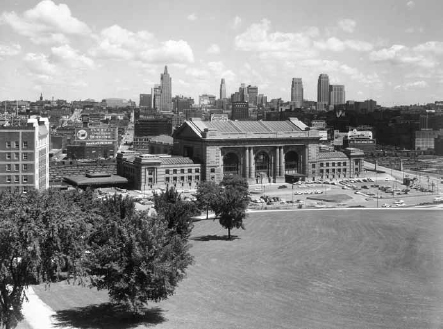
INTRODUCTION
Keep your places, objects than which none else is more lasting!
—Walt Whitman, “Sun-Down Poem,” 1856
A time traveler from the twenty-first century, I’m standing on the observation deck of the Liberty Memorial, looking north across the monument’s newly mown lawn toward the skyline of Kansas City, Missouri, circa 1950. It is summertime and, according to the clock on the Kansas City Southern Lines billboard, 10:49 in the morning.
I see some familiar landmarks: Union Station, for instance, and the Power and Light Building, city hall, Municipal Auditorium and the dome of the Cathedral of the Immaculate Conception. And I see things that are missing from the twenty-first century: train sheds behind the station, the Jones Department Store, the hotels Continental and Kansas Citian, whole blocks of buildings and sidewalks and trees not yet obliterated by freeways.
Here, the H.D. Lee Company still has its headquarters in the nine-story brick building behind Union Station, and members of my mother’s family still work there. From the Lee building, it’s a short walk in either direction to the former T.J. Pendergast Wholesale Liquor Company or to the second-floor office that belonged to Pendergast.
In 1950, Boss Tom has been dead five years.
Paris of the Plains—some could say that’s pretty highfalutin for a rough-cut cattle town. Or they could point out a fudge on both ends: Kansas City is neither French nor on the Great Plains, which begin a hundred miles west.

The view from Liberty Memorial, circa 1950. Courtesy of Missouri Valley Special Collections, Kansas City Public Library, Kansas City, Missouri.
Years ago, journalists compared Kansas City to Paris because of a sin-soaked nightlife. It was during the city’s jazz heyday, usually defined as the period between the wars, the Pendergast era of corruption and vice that ended after the Democratic political boss was convicted of income-tax evasion. Tom’s town became respectable. Some say, lifeless.
But while Paris of the Plains is a nickname of vague historical origin, from where I’m standing this morning in 1950, it’s more than the sum of its parts. It feels as if it has transcended Boss Tom. The name sings, and the song is about—let’s say—je ne sais quoi.
I see clues in the signage visible on the skyline. People here drink Falstaff and Country Club (“Kansas City’s Largest Selling Beer”), but they also play Steinway pianos. They are high tech with their Admiral television sets, but they still travel by train with fantasies of the Old South (“Southern Belle to New Orleans”). It’s a real city; it’s a state of mind.
And because I’m a time traveler, I can see over the horizons of this city/ state, bracketed by old city limits—the Missouri and Blue Rivers, Eighty-fifth Street and State Line Road—and by events symbolic of beginning and end: the birth of its great monument to a war to end all wars and the death of its street railway. It spans sixty square miles and almost forty years, a period of growth from just more than 300,000 citizens to just under half a million. It’s an era when the promotional tagline changes from “one of the most American cities”—its boosters mean “native-born”—to “the embodiment of aggressive Americanism”—as distinguished from Soviet communism.
And I can see beyond the muddy rivers, the sooty train sheds and the stinking stockyards. The perfumed ladies of this place shop at Harzfeld’s Parisian. A fine hotel serves a one-dollar Parisian Surprise Luncheon. Parisian girls dance in the dreams of soldiers returning home from the war. Here’s a vaudeville theater resembling the Paris Opera House; a war memorial inspired by the great Parisian monuments; and a thousand-foot-tall television antenna known as the “Eye-full Tower.”
It’s the town my family showed me as a young boy—a town of railroads, smokestacks and screened porches; cows and hogs; elm-canopied streets; and women in straw hats and old men in suspenders. It’s got a zoo, a ballpark, an art museum, a fleet of cream-and-black streetcars and restaurants serving tomato aspic and gooseberry pie. It smells of lilacs and just-baked bread and something foul drifting in from the stockyards. Cicadas provide the soundtrack, accompanied by radio baseball and the clip-clip-clip of a lawn sprinkler.
It’s also the town my straight-laced ancestors tried to ignore—the one Tom Pendergast helped create—a place of need and greed, anguish and demonic joy. It’s a black and white place—that is, a place for whites there and, over here, a place for blacks. It’s also a blues place, and the soundtrack might include gunshots, blue notes from a saxophone or the distant whistle of a night train.
So this is an attempt to know a place by excavating fragments of its time, many of them obscure or forgotten. They include white elephants, plastic bulls and swimming hogs; innocent bystanders, wayward sleepwalkers and doomed lovers; and yes, Rudolph Valentino, Lou Gehrig and Count Basie, but also Arthur Mann, Nancy Jordan and Albert Stewart.
Anything but lifeless, it’s a real place where people work, play, love, hate and dream. They seem to know who they are, and they’re happy to be Kansas Citians. For such a place, the name is a comfortable fit. Paris of the Plains: where grit meets grace.